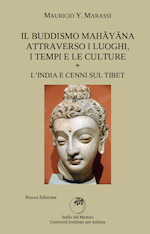I) The titles
The title of my presentation has been pilfered from the English translation of Dasheng Qixinlun (1), or Treatise on the Awakening of Faith in the Mahāyāna, which I consider the most important literary contribution to the development of Mahāyāna in East Asia. In translation (2), the sentence I had in mind reads like this: “The process of actualization of enlightenment is none other than [the process of integrating] the identity with the original enlightenment”. For those who understand Japanese, the text is this: 始覚 は 即ち 本覚 に 同じき を もって成り (3).
I used this quote to have a chance to introduce this ancient text, but, to judge from my own experience, it would have been more accurate to speak of a “process of melting — rather than integration — of the individual identity into the absolute”. Perhaps I should have used another heading for this presentation after all!
In the same line of thought, I would like to congratulate the organizers on the choice of a very appealing title for this colloquium. The “universality of Buddhism” is truly a magnificent subject.
But what do we mean by universality? At the risk of imitating Lapalisse, “universality” derives from “universe”, which, in turn, literally means “that which is only one”, or, “that to which there is no alternative”. Does it refer to “something that is forever, everywhere, for everybody” and, if so, is universality a property of Buddhism?
Or do we want to say instead that Buddhism is a particular form of universality? After all, to be actualized, the universal must become particular, it must take on a specific form.
Yet again: how can we look for universality in Buddhism? Buddhism does not exist: it is a figment of our imagination. It is a fiction. There is nothing that I can grasp – even conceptually – and bring before you and say: “Here it is, this is Buddhism, what do you think?”.
We can say the same about the Buddhists. We are not an anthropological category, or an ethnic group, or people who share the same aspect, whom someone can put under a magnifying glass or display pinned to the bottom of a showcase.
To begin addressing some of these issues, we shall explore the ways in which Buddhism and universality overlap. We will outline the historical process that, starting centuries ago and reaching up to our own times, brought a part of mankind to give universality the names of buddhadharma, fofa (仏法), fodao (仏道), buppō (仏法) and buddhism; in other words our hypothesis is that buddhism is one of the languages spoken by Universal. Be aware, though, that buddhism is not a Buddhist term. It was dreamt up by the British. After they conquered India, they found it convenient to classify the Indian religious experience and, for simplicity’s sake, they came up with these three categories, jainism, hinduism and buddhism.
II)The journey of mankind towards the absolute
Let’s go back to where it all started. The archaeological finds of Harappā and Mohenjo Daro, on the Pakistani banks of the Indus have confirmed what years ago could only be conjectured. Before it was finally brought down by foreign conquerors, called Arians -from arìh, the Sanskrit root for “foreigner”- a highly complex culture flourished in this area; a culture that, at that time, went further than any other in developing the capacity to enter into communication with the absolute through the body (4). I am talking of a practice that plies the body to a religious end, that makes it the place, the very spot where the earthbound and the infinite meet.
In this culture, the early growth of Religion, its very birth perhaps, coincided with the process whereby the shamans turned ascetics. In this process, they developed the capacity to enter into contact with the absolute through their bodies, thanks to special practices and bodily gestures that they had identified through trial and error as the most effective to establish that contact. These practices centred on the cross-legged position, which had been proven even earlier than 1000 b.C. to be the most conducive to transform the human body into the abode of god.
At least for what concerns its physical aspects, this is the origin of what many centuries later would be called yoga, “unity [with the absolute]”, and after an equally long evolution, of what we now call “zazen”.
Through one of the paths taken in the long and original process of refining the Dravidic cult of the Mother Goddess, this culture also built the foundations of the religious pantheon that contributed the figure of Śiva (5) and many centuries later bestowed to Buddhism the figure of Avalokita Īśvara, latterly Kuanyn and, more recently, Kannon or Kanzeon (6). From the original core of protoyoga and protoshivaism also bloomed the practices that, many centuries on, led to tantrism, to Vajrayāna and Tibetan Buddhism, to Shingon, and so on and so forth.
Notes:
1) 大乗起信論, better known in the Japanese religious literature as Daijō Kishinron.
2) Hakeda Y.S, The Awakening of faith, Columbia University Press, New York 1967, 37.
3) Transliterated with the Hepburn system: “shikaku wa sunawachi honkaku ni onajiki wo motte nari”.
4) Parenthetically, I am using the word “absolute” in its original etymological meaning, which is “untied, free from any straitjacket, beyond any limit”.
5) Cf. A.C. Bouquet, Comparative Religion, Penguin Books Ltd., Middlesex 19637, chapter VII.
6) Cf. L. De La Vallée Poussin, entry: “Avalokiteśvara”, in Subodh Kapoor, The Buddhists: encyclopaedia of Buddhism, Cosmo Publications, New Delhi 2001, I 122 n.9.
| « Back |
Part two » |
Se volete, lasciate un commento.
You must be logged in to post a comment.







